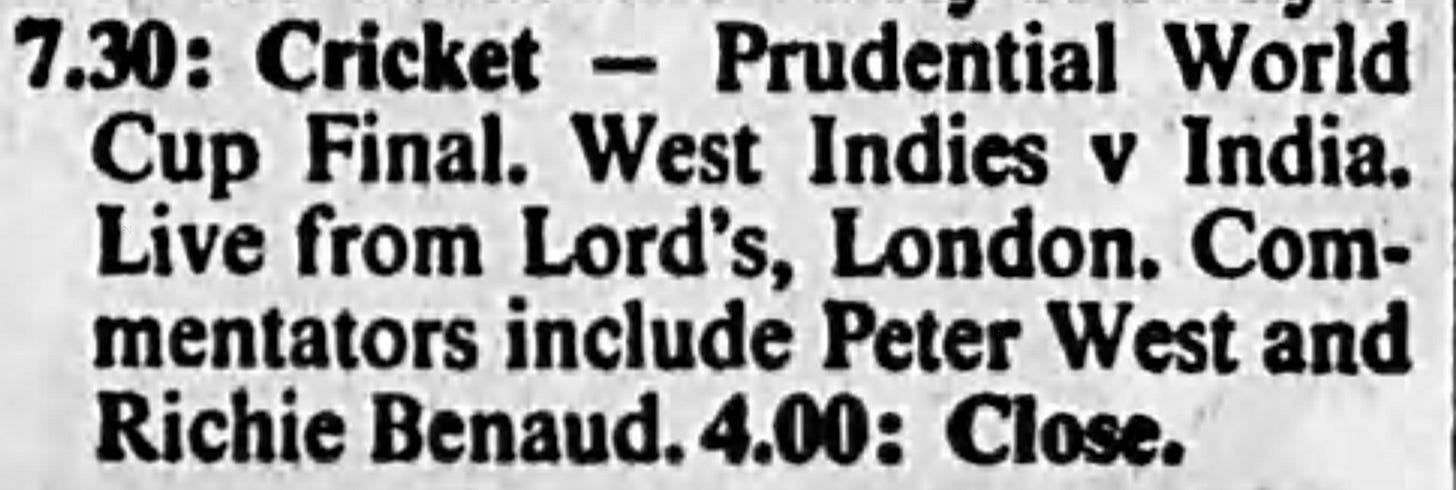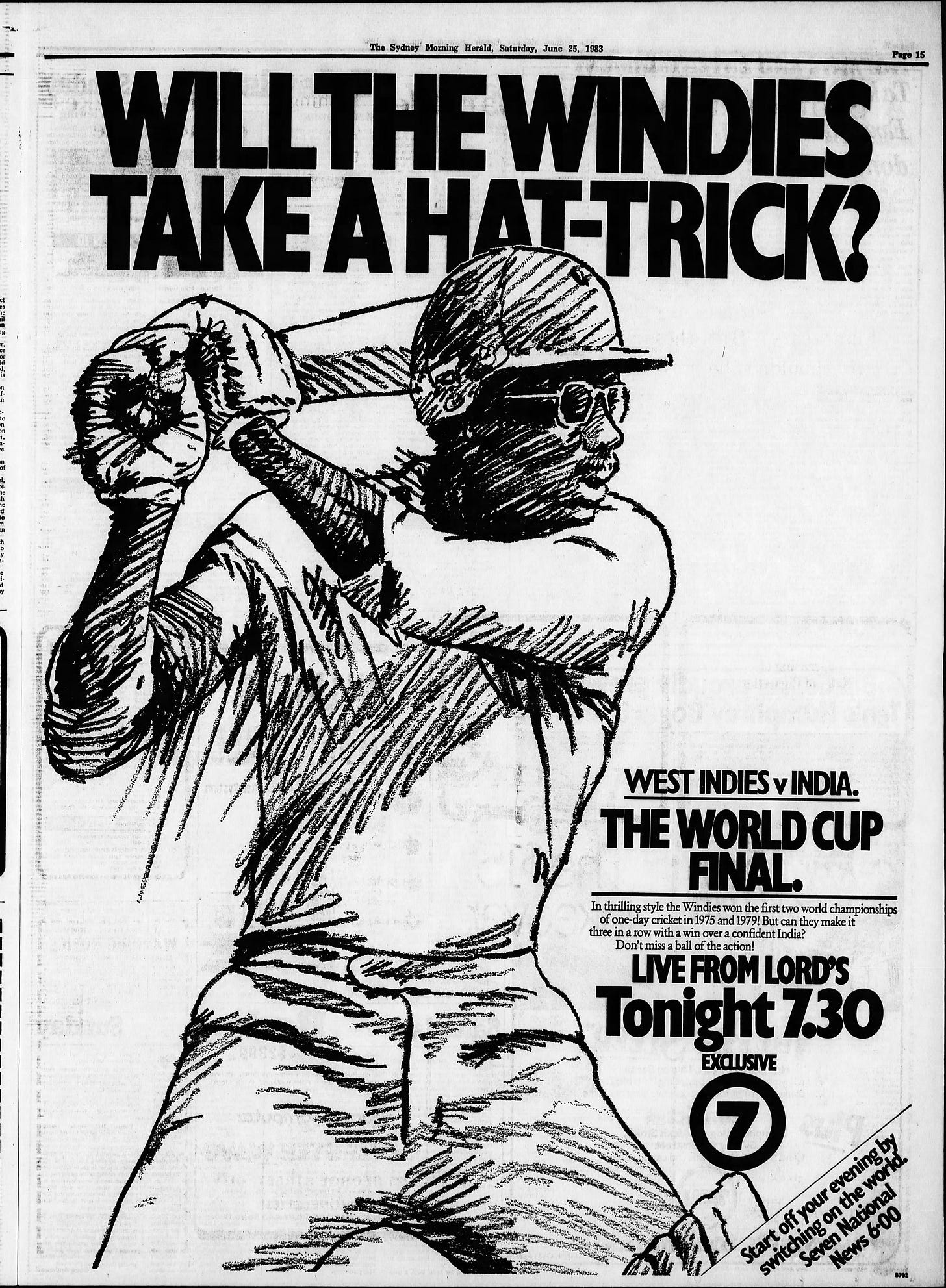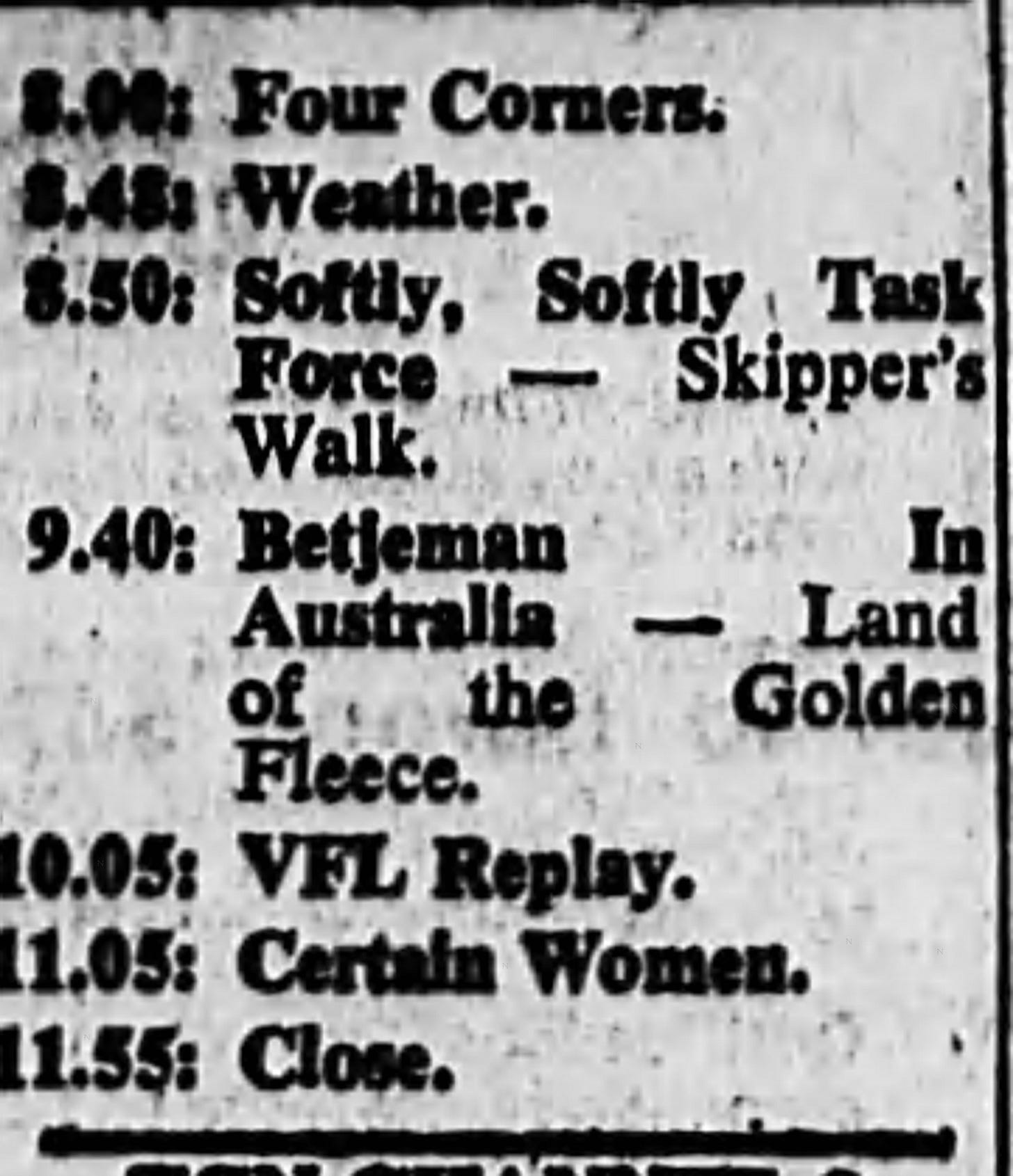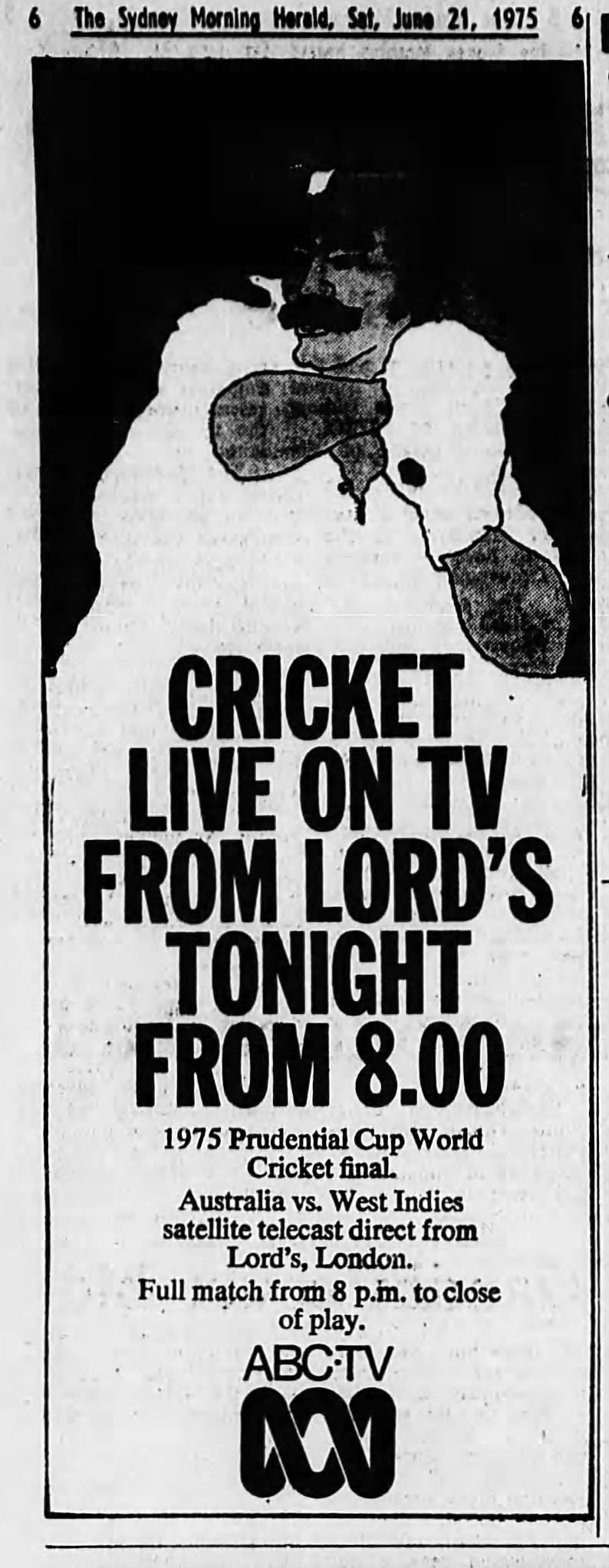Ball 1
The Indian side is better than Australia and they duly knocked Australia out in the semi final.
It was the result most had expected and, if you didn’t see the game, the scorecard indicates it was pretty comfortable.
What might not be apparent though is that when India lost their second wicket, the win predictor gave Australia a 60% chance.
It was about one in the morning in Sydney and I was rather excited. The nature of the two wickets had given me a surge of optimism: Gill had dragged one on off Dwarshuis - a clear indicator, I told myself, that the pitch was keeping low. And Connolly had got the mighty Rohit Sharma out in his first over. Put it this way, if arguably the sixth best spinner in Australia’s eleven was so dangerous on this track imagine what Zampa, Sangha, Maxwell, Head and Labuschagne might do!
Boy was I in for a disappointment.
Shreyas Iyer joined Virat Kohli and the pair put on the safest partnership in ODI history. They defended a few and hit a few to the fence. But mostly, they skilfully deflected decent balls into the gaps and jogged singles.
It was everything I have come to dislike about one day cricket: impressive, sure, but dull, and although the Aussies fought hard, the inevitability of their defeat became obvious with alarming rapidity.
That is not meant to sound bitter - India really is a better side and deserved to win. But I do think the ODI format is struggling, especially in Australia (see Ball 5).
Smith’s captaincy has been credited for keeping Australia in the game for so long.
I am not so sure.
I don’t think he captained poorly or any differently to how Cummins would have, but I think there came a point where he needed to gamble and bring extra fielders into the circle. Most likely this would have seen India win even more quickly, but at least it might have given the Aussies a chance.
Dan Norcross made an insightful point on the Final Word podcast after the game. He said that Australia had been spooked by the pitch in the India-New Zealand game from a few days earlier and this caused them to abandon their plan of bowling first against India.
As it turned out, the pitch was the best batting pitch seen in Dubai all tournament. The Aussie spinners (including the extra one they brought in - Tanveer Sangha) were not effective and, if anything, the pitch was easier to bat on in the night. According to Norcorss, Australia should have stuck with their original plan.
I think he is probably right - not that I can join in the criticism of the Aussies: at the time I agreed with their approach. I was joyous when they won the toss and would have been furious if they had not chosen to bat.
Three dropped catches did not help, nor did Smith and Maxwell being dismissed in quick succession just as Australia had looked set for a 300-plus total. But, on the whole, I think Australia played pretty well in the tournament, especially given Cummins, Starc, Hazlewood, Marsh, Stoinis and Green were missing.
Ball 2
Looking at the two ODIs played in Sri Lanka and then our Champions Trophy Campaign, here are some players who have gone up or down in my estimation.
The ups
*Alex Carey: I already thought highly of him but he has had a stellar few weeks. He has gone from being on the ODI outer to one of the very first batters picked.
*Josh Inglis: Inglis’s hundred against England capped off a spectacular few weeks for him. It will be interesting to see if he maintains his spot in the side for the World Test Championship final.
*Nathan Ellis: Proved that he is worthy of being in Australia’s best ODI side, even if all the big guns return.
*Steve Smith: I mean he could hardly have gone higher, but I just wanted to mention him and say it is a pity he has retired. If he is still batting at this level in 2027, the selectors should beg him to return just for the ODI World Cup.
The downs
*Jake Fraser-McGurk: At the moment I would not have faith in him on anything except a belter. Hopefully he proves that he is better than this - and I still have hope: you can’t play some of the innings he has played without great talent.
*Cooper Connolly: Looked out of his depth in his nine-ball duck in the match against India. However, as with Fraser-McGurk, I am hopeful that he is capable of rising up again. To be fair, he was Australia’s most economical bowler in the India game.
*Spencer Johnson: Bowled some superb balls and, at his best, is a weapon. Too inaccurate for me at the moment. Brett Lee and Mitchell Starc tightened up their accuracy as their careers went on: can Johnson do so too?
*Tanveer Sangha: A bit harsh probably, given he got limited opportunities. Hard to see him in Australia’s side in the immediate future but he’s only 23 and legspinners are often not at their best until 30.
Ball 3
India were unfairly advantaged by the way this tournament was set up.
That should be an uncontroversial statement - and indeed it is uncontroversial outside India. Here is a short, incomplete list of India’s advantages:
*India got to play every match at the same venue
*The conditions at India’s venue were very different to the conditions in Pakistan. Other sides had to pick squads for both Pakistan and UAE; India did not.
*Other sides were required to travel to a farcical extent: the necessity for South Africa to fly to Dubai and back without playing a game is absurd. And so is what New Zealand have had to do: in the last few days they have played a game in Pakistan, flown to Dubai and played a game, flown back to Pakistan to play a game and now have flown to Dubai to play the final. All while the Indian team has been checked in at the one hotel.
Why is this so hard for some Indian commentators and fans to acknowledge?
All manner of irrelevant and obfuscating defences are raised, including:
*What about how in the 2023 World Cup India had to play each match in a different venue?
*If you don’t like it why did you let India play at all? It’s because you know that without India, global cricket will collapse
*The ICC set the schedule, not India
*When England and Australia ran cricket India were not treated well. It’s time for you to experience what that was like
*The flights between Pakistan and Dubai are short
*’Why don't you actually look at why your team has not qualified?’ This is what Sunil Gavaskar actually said in response to Mike Atherton and Nasser Hussain’s balanced criticisms of the tournament.
I like Gavaskar and most of the time he is a decent commentator. He is a cheerleader for India but I respect his passion - far better to have someone who actually really cares (remember his ‘Stupid! Stupid! Stupid!’ outburst at Rishabh Pant during the Boxing Day Test) in the commentary box than so many ex players who admit to only doing it for the cash.
What I find disappointing - albeit understandable - is that we are not hearing much out of the more objective Indian commentators. Surely it is fine to say ‘India is the best team in the world; it cheapens their achievements when they get given these advantages.’
I’m being hypocritical no doubt. Making such statements could genuinely result in their sacking and impact their livelihood. It would take a brave person - or one right at the end of their career - to do so.
(In the unlikely event that the BCCI ever offer to hire me, I will no doubt cravenly delete this column, lol).
Ball 4
With Australia’s exit from the Champions Trophy, so begins an unusually lengthy period of no international matches for the men’s team.
The reason for this is the IPL, which this year will go from 22 March to 25 May.
I thought it might be handy to go through what’s ahead of the Aussie team, once the IPL concludes.
11-15 June (with 16 June a reserve day for rain): World Test Championship Final, Lord’s
Should be one of the sporting highlights of the year. However, as things stand, it will only be available on Amazon Prime in Australia so the viewing audience will be small. Channel Seven were supposedly in talks with Prime to co-broadcast the match, so here’s hoping.
June-July: 3 Tests and 5 T20s in West Indies
The West Indies’ thrilling win at the Gabba last summer earnt them a third Test. While this is welcome news, watching Test cricket in the West Indies in recent years has been depressing: crowds of near zero and flat pitches. The glory days of big crowds and big atmospheres of 1991, 1995 and 1999 seem long ago.
August: 3 ODIs and 3 T20s v South Africa, in northern Australia
Another bizarre, self-sabotaging little cricket series. Take a great rivalry, stick it in small cities with small stadiums, make sure absolutely nothing is as stake and play it in the middle of winter, just as the football seasons are heading to a climax.
October: 3 T20 tour of New Zealand
Another meaningless little series but at least it should get good crowds and is after the NRL and AFL grand finals. This might be a good one for Channel Seven to bid for. The Australia-NZ cricket rivalry could explode into something massive if shown a little love.
November: 3 ODIs and 5 T20s v India, in Australia
Money, money, money! There is nothing wrong with money, of course. And matches against India are always worth watching. If I had my way, the three ODIs would be ditched and we’d get Pakistan out here as well and make it a T20 tri-series to remember! Oh, and get it on free-to-air television too.
November 2025-January 2026: 5 Tests v England in Australia
For many casual fans, this Ashes series is when they will next be aware of the existence of cricket. I cannot wait!
February 2026: 3 T20s in Pakistan
A good pub trivia question for March 2026: who won the recent T20 series between Pakistan and Australia? Cue puzzled faces.
February-March 2026: T20 World Cup in India and Sri Lanka
Yep, I know what you’re thinking: how many T20 world cups can there be?! Nevertheless, I am looking forward to it immensely.
March 2026: 3 ODIs in Pakistan
A good pub trivia question for April 2026: who won the recent ODI series between Pakistan and Australia? Cue puzzled faces.
Ball 5
I wrote last week about how I now favour ODIs being reduced to 40-overs to inject some life back into the format.
There is no doubt ODIs are a waning force in Australia. I decided to check some numbers from the last three decades; they paint a stark picture.
Excluding off-season winter games, the 2015 World Cup and games against the ICC World XI, here is how many ODIs have been played in each summer in Australia, from 1997/98, through to 2026/27 (according to the schedule for the next two seasons):
The drop-off is undeniable. Covid did not help, but the trend began prior to the pandemic and has continued after it.
From being the high-point of the summer, ODIs are now in trouble. Personally, I struggle them in full - unless it’s an ICC event. Even then, unless Australia is playing or it is a final, I find myself drifting away once the powerplay ends.
Speaking of ICC event finals, here comes Ball 6 . . .
Ball 6
India and New Zealand play for the Champions Trophy on Sunday night and, as I have been going on about, few people will be watching in this country, as a result of the tournament being on Amazon Prime.
It’s not such a big deal given the low profile of the Champions Trophy, but what will be a big deal is if the 2027 50-over World Cup is not on free-to-air. For all my concerns about ODI cricket, the actual world cup is still a stand-out: by far the most significant trophy in world cricket.
As things stand, the 2027 tournament will be on Amazon Prime only. As such, the final of the 2027 50-over World Cup - cricket’s showpiece event - will have a tiny audience in Australia.
This got me thinking: when was the last time that the World Cup final was not on free-to-air television in Australia.
Well, the recent ones (2023, 2019, 2015, 2011, 2007, 2003, 1999, 1996 and 1992) have all been on Channel Nine, all live and in full.
What about before that?
1987: Channel Nine did not show Australia’s first World Cup triumph in full. They showed the first innings live but once 6pm hit on the east coast, they switched to normal programming - including a repeat of a 1984 Dudley Moore film! Viewers had to wait until 10:35pm for two hours of extended highlights in order to see Allan Border lift the cup.
1983: A surprise - I just assumed it wasn’t shown. Well, it was shown - live and in full - on Channel 7.
If you’re wondering why Richie Benaud, stalwart of Channel Nine was on Seven - he wasn’t really: Australia just took the BBC coverage. Benaud was, of course, a fixture on the BBC in England for decades.
Seven even took out a full page ad in the Sydney Morning Herald. Nine, by the way, was showing Wimbledon.
1979: An even bigger surprise. I was sure this had not been shown. And when I checked, sure enough it was not on ABC or Nine or Seven. For completeness, I glanced at Channel 10 . . . and there it was! The first few hours were missing - it was vitally important to show a replay of the 1955 movie Battle Cry - but towards the end of the first innings coverage began and proceeded in full till the end.
1975: And so back to the first ever men’s World Cup, in which West Indies took on (and narrowly beat) Australia.
If you went just by the television guide, you would conclude it had not been shown.
And this would not be a surprise - back that far, cricket had only been shown live from England into Australia once - the final day of the final Test of the 1972 Ashes.
But a surprise was in order. In an evidently last minute decision, ABC decided it would broadcast the match: not in time to have the television guide in the Sydney Morning Herald updated, but in time to take out an ad on page 6 of the same paper:
As it was, the game lasted deep into the night, finishing with a trophy presentation to Clive Lloyd by Prince Philip at 5:45am! (8:45pm London time).
So the answer is that every final has been broadcast on free-to-air television in Australia and usually in full.
It will be a crying shame if the 2027 final sees this streak broken.









